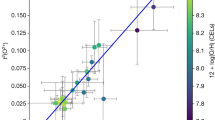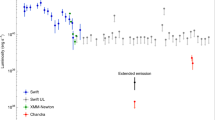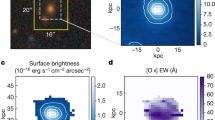Abstract
THE electron temperatures of diffuse gaseous nebulae have long been thought to be close to 104 K. Much lower temperatures were derived from some of the early radio continuum and recombination line work, but these were generally considered to be wrong for a variety of reasons (cf. the review by Seaton1). However, most of these considerations applied only to the easily measurable bright nebulae like Orion, and these are expected to be at high temperatures because of their high densities and the effects of collisional de-excitation on cooling agents such as oxygen and neon ions2. While there is little doubt that the bright nebulae do indeed have temperatures of ∼8,000–9,000 K (refs 3–5), there are strong indications that some nebulae of lower densities have much lower temperatures, ≲4,000–5,000 K (ref. 5). We have made radio recombination line observations of several low-density nebulae, in order to determine electron temperatures in the absence of such effects as collisional de-excitation, stimulated emission, and pressure broadening. Several of these nebulae have been found to have temperatures below 5,000 K, and for two of them which are discussed here (RCW94 and G339.1–0.2) absolute upper limits of ∼4,700 K are imposed by the line widths alone.
This is a preview of subscription content, access via your institution
Access options
Subscribe to this journal
Receive 51 print issues and online access
$199.00 per year
only $3.90 per issue
Buy this article
- Purchase on Springer Link
- Instant access to full article PDF
Prices may be subject to local taxes which are calculated during checkout
Similar content being viewed by others
References
Seaton, M. J. Q. Jl R. astr. Soc. 15, 370 (1974).
Osterbrock, D. E. Astrophys. J. 142, 1423 (1965).
Peimbert, M. & Torres-Peimbert, S. Mon. Not. R. astr. Soc. 179, 217 (1977).
Wilson, T. L., Bieging, J. & Wilson, W. E. Astr. Astrophys. 71, 205 (1979).
Shaver, P. A. Astrophys. Lett. 5, 167 (1970).
Wilson, T. L., Mezger, P. G., Gardner, F. F. & Milne, D. K. Astr. Astrophys. 6, 364 (1970).
Burbidge, G. R., Gould, R. J. & Pottasch, S. R. Astrophys. J. 138, 945 (1963).
Balick, B. & Sneden, C. Astrophys. J. 208, 336 (1976).
Johnson, H. M. Publ. astr. Soc. Pacific 85, 586 (1973).
Sarazin, C. L. Astrophys. J. 211, 772 (1977).
Shaver, P. A., McGee, R. X., Murdin, P. G. & Goss, W. M. Astr. Astrophys. (submitted).
Author information
Authors and Affiliations
Rights and permissions
About this article
Cite this article
SHAVER, P., McGEE, R. & POTTASCH, S. Cool gaseous nebulae. Nature 280, 476–477 (1979). https://doi.org/10.1038/280476a0
Received:
Accepted:
Published:
Issue Date:
DOI: https://doi.org/10.1038/280476a0
This article is cited by
-
Peculiar optical spectrum of the Red Rectangle
Nature (1981)
Comments
By submitting a comment you agree to abide by our Terms and Community Guidelines. If you find something abusive or that does not comply with our terms or guidelines please flag it as inappropriate.



